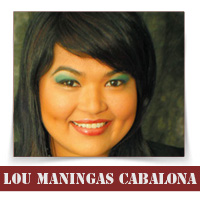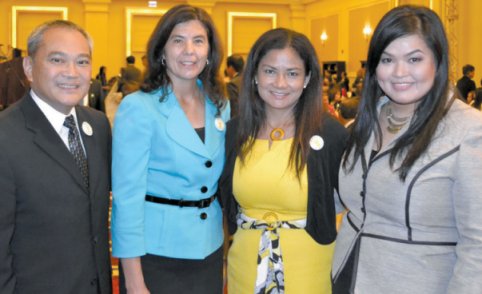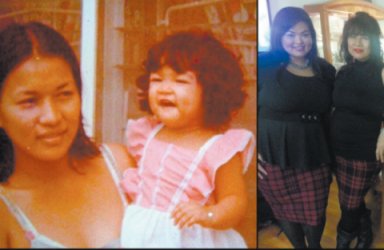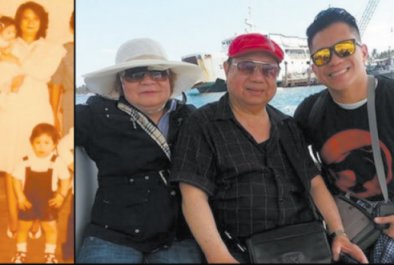By: Lou Maningas Cabalona
“Ladies and gentlemen, mga minamahal kong kababayan, Magandang Gabi po sa inyong lahat. And I apologize to our American friends; it is my custom to talk to my countrymen in our native tongue.” The President of the Philippines gently asked for pardon for addressing his 600 plus audience in Filipino in his first and latest Chicago visit last May 6.
He then shared two jokes that are best delivered in the same language and each one was received by a roar of laughter.
After warming up the crowd, I expected he would switch over to English anytime soon. After all, there were a number of non-Filipino looking guests and from what I remember, high ranking government officials always spoke in the widely accepted “business” language, English.
President Benigno Aquino, however, continued on to talk in Filipino in the first 3 minutes, then 5, then 10. Only when he started mentioning the accomplishments of his term did I embrace the fact he would be delivering his speech entirely in Filipino!
Slowly, my quiet acceptance was replaced by an unexpected feeling that I was made to feel important. Important because, with his simple gesture, the highest ranking official of the Philippines showed it was more important to ensure I (and the rest of our countrymen) understood his message completely, over satisfying the curiosity or pleasing our foreign guests. I say this at the expense of sounding selfish but anyone who is familiar with Philippine history or current politics would easily agree this welcome “bias” is not a common occurrence.
I also felt pride in being a Filipino American who understands and speaks my two languages fluently. I was proud that this very special occasion reinforces our efforts to keep the Filipino language alive in our family, in our community.
Did you know that growing up in the Philippines, my mom decided to raise all of her children learning English first? I know its sound almost contradictory but indulge me for a moment. You see, my mom was sure we could learn Filipino quickly. Knowing that English is a valuable skill to have, she wanted to make sure we were a step ahead in mastering it.
Now, I am in a similar situation. Should I be blessed to have kids, they will learn Filipino first from me because it’s a valuable skill to have and I want to make sure they are a step ahead.
With the positive growth the Philippines is experiencing over all, many young entrepreneurial Filipinos all over the world are beginning to tap the Philippines as a viable venue for growing their business or craft. Whether my kids decide to spend their summer vacation with grandparents, or study in Manila or set up a business in Tacloban, they will be all set!
I understand though, it is easier for us, now that we are living in a time where diversity is accepted and even celebrated; that not too long ago, it was best for immigrant families to assimilate with American life and culture resulting in many FilAms growing up without having any exposure to anything Filipino other than eating lumpia, pancit or adobo.
My friend’s facebook post during the presidential speech was a testament to that. She shared “Philippines came to Chicago today and I have no idea what’s being said” requesting for a “#TranslationPlease”.
The good news is that it is not too late for anyone, of any age. I promised my friend I would help her learn Filipino or Tagalog, the language it is based from. For those of you who are also interested, here’s a few quick tips I’ve gathered from others who also (successfully) tried to learn a new language.
Take advantage of resources online.
There are a ton of websites online. Whether you go for free resources or you feel investing in Rosetta Stone or Pimsleur, pick one and stick with the courses.
Conversation, Conversation, Conversation.
For all polyglots I’ve read about, the most important thing is to keep conversing with someone who is fluent in Tagalog. Exercising what you learn in real life conversations, no matter how good or bad you are, will keep you motivated. It helps you remember things better and you are able to pick up more nuances that is not available in books.
Find a partner.
Number two might subsequently help you in finding a language buddy. If you can’t find one in your circle, try asking friends and relatives for other friends you can video chat with online! I am sure people will be more than willing to help. You might gain a new friend too. While I have not tried this myself, www.mylanguageexchange.com is a free website that allows you to pair up with someone to learn each others language. You can help teach someone English while they teach you Filipino.
TV shows, movies, newspapers and magazines are a good supplement.
This is where your mom’s TFC or GMA Channel subscription comes in handy. I’ve heard a couple of stories where people have claimed to learn Tagalog by just watching TV and maybe there’s some truth to that. By watching TV or reading news, you will also be kept abreast with current happenings and trends in the Philippines. I found a couple of online newspapers are published in Filipino: www.gmanetwork.com/news/ulatfilipino and www.balita.net.ph
Keep a diary.
The most effective way to remember things is to write things down. Keep entries of words or phrases you learned and what they mean and keep using your “words of the day” as much as you can in conversations. When you feel like it, write down your thoughts in Filipino even if it is full of mistakes. If you keep at it, it would be wonderful to see your progress day after day.
Finally, the best thing about conversational Filipino is, it is widely used in conjunction with English words. So, even without lifting a finger, you’re a third of the way there already!
————
Louella Maningas Cabalona is a singer, actor, and a Business Intelligence Consultant. She is the co-founder of the Filipno Folk band, SamaSama Project, ILPRO (Illinois Philippines Recovery Operations) and the soon to be launched FilipinoAcademy.org. One of the 10 inaugural delegates of the FYLPro Immersion program of the Philippine Embassy in DC in 2012, she is currently serving as a “language buddy” for a friend, co-organizing a festival for musicians and healthcare professionals, while planning the next series of 2016 medical missions to the Philippines with her husband, Baron. If any of these adventures sound interesting to you, email louellarose@gmail.com.
Sheryl Mesde (left) visiting from the Philippines with Media personalities who cover news in both Filipino and English, Louella Cabalona of CPRTV, ANC Channel’s Ces Oreña-Drilon, Connie Macatula-DeLeon and Paul Henson of ABS-CBN News.
Ben Corpuz, SamaSama Project’s Keyboardist, Cook County State’s Attorney Anita Alvarez, Cook County Judge Jessica O’ Brien and
Louella Cabalona representing SamaSama Project and the Philippine Embassy’s Filipino American Young Leadership Program (FYLPRO).
Left, year-old Louella with mom, Sally Mesde. Right, mom and daughter in matching outfits during Thanksgiving 2014.
My husband, Baron, grew up in the USA learning both Waray and Tagalog from his parents. Left, toddler Baron, posing in front of mom, Genia. Right, Baron with parents, Genia and Orlando Cabalona.
 VIA Times – May 2015 Issue Vital News, Vibrant VIews for Asian Americans in Chicago & Midwest
VIA Times – May 2015 Issue Vital News, Vibrant VIews for Asian Americans in Chicago & Midwest








